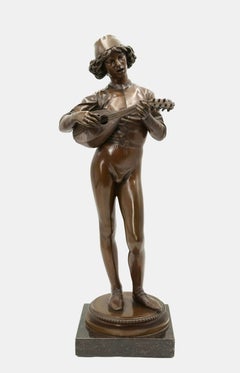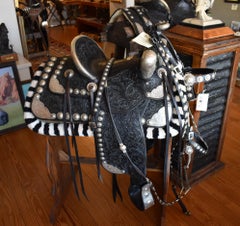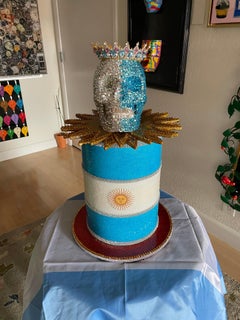Paul Dubois Art
to
1
1
Overall Width
to
Overall Height
to
1
1
1
1
1
1
1
1
6
7
2
2
2
1
Artist: Paul Dubois
Dealer: Arcadia Art
Florentine singer / - The Renaissance of the Renaissance -
By Paul Dubois
Located in Berlin, DE
Paul Dubois (1829 Nogent-sur-Seine - 1905 Paris), Florentine singer, 1865. Light brown patinated bronze with cast round plinth mounted on a square marble base (3.5 cm high). Total height 53 cm. Bronze dimensions: 49.5 cm (height) x 20 cm (length) x 10 cm (width), weight 5.6 kg. Inscribed on the plinth "P.[aul] DUBOIS", dated "1865", with the foundry's mark "F. BARBEDIENNE FONDEUR" and the signet "REDUCTION MECANIQUE A. COLLAS".
- Patina very occasionally darkened, lute with loss of one tuning peg, otherwise in excellent condition.
- The renaissance of the Renaissance -
The bronze is a precisely executed and masterfully cast contemporary reduction of Paul Dubois 155 cm tall masterpiece "Florentine Singer", which is exhibited in the Musée d'Orsay and for which the artist was awarded the Medal of Honor at the Paris Salon in 1865. The work acted as a beacon, and was followed by a plethora of depictions of juveniles.
Inspired by Donatello and Luca della Robbia, but also by painters such as Piero della Francesca, Benozzo Gozzoli, and Pinturicchio, the "Florentine Singer" is not an epigonal work that pays homage to a vanished era, but a successful attempt to draw vitality from the art of the past and thus give it new life.
The effect of vitality is the core of Italian Renaissance art theory. In order to fulfill itself as art, art had to appear like nature. This naturalism also characterizes the "Florentine Singer". The young man appears to have been taken from life, which is reinforced by the momentary nature of his action. He has just struck a now fading chord. In addition, the natural appearance is enhanced by the detailed shaping of the figurative details, such as the laces with the slightly curved leather of the shoes, the belt buckle, or the ornamentation on the body of the lute. Even the fingernails are clearly defined. Unlike the Renaissance, however, the effect of liveliness here is not based on the "discovery" of nature and the human body, but primarily on the rediscovery of the art of the Quattrocento. The liveliness of the artwork is therefore at the same time a revitalization of this art, so that we can speak of a Renaissance of the Renaissance, just as the Pre-Raphaelites in England at the same time transferred the Quattrocento to contemporary art.
Dubois takes on the most difficult of all subjects, the depiction of singing through silent sculpture. He was preceded in this by Luca della Robbia and Donatello with their pulpits of singers created in the 1430s in the Museo dell'Opera del Duomo in Florence. Compared to these works, the physiognomy of Dubois singer is far less animated, yet he also depicts singing in a convincing manner. He uses the whole body. He takes the ancient contrapposto, which was essential to Renaissance sculpture, and transforms the standing leg-playing posture into a late medieval S-swing, giving the body an elegant beauty and at the same time setting it in melodic motion. In the equally elegant finger position, the music is expressed in a much more literal way with the beating of the lute. Finally, the musicality of the sculpture culminates in the face with the mouth open to sing.
Through the act of singing, which is a great challenge to the artistic will to depict perfect beauty, the gracefulness of the classical face is not diminished, but enhanced. Starting from the face with the singing mouth and the gaze absorbed by the sounds, the inner vitality spreads, giving the bronze sculpture an intense aura, enhanced by the music. Dubois transfers the beauty of the Renaissance to the musical, sublimating the visible sculpture to the invisible of music.
He took up the challenge of transcending the Renaissance with the Renaissance, thus responding to the Querelle des Anciens et des Modernes, which arose at the end of the 17th century around the French Academy and remained virulent into the 19th century, in which antiquity was regarded either as an unattainable ideal or as a standard to be surpassed. With his work, Dubois proved that the Renaissance, which had championed the art of the ancients, could lead to a new renaissance of art.
About the artist
Paul Dubois' great-uncle was the famous French Baroque sculptor Jean-Baptiste Pigalle, in whose footsteps the talented great-nephew followed. When he debuted at the Paris Salon in 1858, he signed his work "Dubois-Pigalle". At his father's request, however, he first studied law before devoting himself to sculpture under the tutelage of François Christophe Armand Toussaint in 1856 and entering the École des Beaux-Arts in 1858. From 1859 to 1863, he lived in Rome and traveled to Naples and Florence. Inspired by Florentine art of the quattrocento, Dubois initiated a school-forming neo-Florentine style that combined the elegantly simple forms of youthful grace with a precise wealth of detail.Two purchases by the French state (“envois de Rome”) were made during his stay in Rome, which brought him recognition in Paris. After his return there, he quickly became an internationally sought-after artist.
Dubois was also active as a creator of monuments. His most famous work is the equestrian statue of Joan of Arc (1896) on the forecourt of Reims Cathedral. He was also a sought-after portraitist who produced around 50 busts and - Dubois was also a passionate painter - around 100 portraits in oil.
From 1873 to 1878 he was curator of the Museum du Luxembourg, in 1876 he became a member of the Institut de France and from 1878 to 1905 he was director of the École des Beaux-Arts.
In 1865, Dubois was awarded the Paris Salon Medal of Honor for his “Florentine Singer”. In 1867 he became Chevalier, in 1874 Officier, in 1886 Commandeur of the Légion d'honneur, which awarded Dubois the Grande Croix in 1896.
Selected Bibliography
Stole, Elmar: Paul Dubois. In: Saur. Allgemeines Künstlerlexikon, vol. 30, Munich - Leipzig 2001, pp. 677-678.
GERMAN VERSION
Paul Dubois (1829 Nogent-sur-Seine - 1905 Paris), Florentinischer Sänger, 1865. Hellbraun patinierte Bronze mit gegossener runder Plinthe auf quadratischem Marmorsockel montiert (3,5 cm Höhe). Gesamthöhe 53 cm. Maße der Bronze: 49,5 cm (Höhe) x 20 cm (Länge) x 10 cm (Breite), Gewicht 5,6 kg. Auf der Plinthe mit „P.[aul] DUBOIS“ bezeichnet, auf „1865“ datiert, mit dem Gießereistempel „F. BARBEDIENNE FONDEUR“ und dem Signet „REDUCTION MECANIQUE A. COLLAS“ versehen.
- Patina sehr vereinzelt nachgedunkelt, Laute mit Verlust eines Stimmwirbels, ansonsten ausgezeichnet erhalten.
- Die Renaissance...
Category
1860s Realist Paul Dubois Art
Materials
Bronze
Related Items
EDWARD BOHLIN 1920s-1930s SILVER ART PARADE SADDLE HOLLYWOOD WESTERN ARTIST VAIL
By Edward H. Bohlin
Located in San Antonio, TX
Circa Late 1920s - Early 1930s. It is all Bohlin made and marked to include the saddle, the headstall and the breast collar. All made in Hollywood California. The only non-Bohlin ite...
Category
1930s Realist Paul Dubois Art
Materials
Silver
EVITA: QUEEN OF ARGENTINA (One of a Kind Swarovski Skull w/ Custom Base + Crown)
By Mauro Oliveira
Located in LOS ANGELES, CA
*New Year Inventory Renewal Sale - 90 Days Until April 30th*
*This Price Won't Be Repeated Again This Year*
***Looking for one of kind precious high ending art piece that no one else will have? This is one of them!***
Absolutely and positively ONE OF A KIND skull creation encrusted with genuine Swarovski and Czech crystals.
The ultimate homage to Evita Peron...
Category
21st Century and Contemporary Contemporary Paul Dubois Art
Materials
Metal, Bronze
"Dancer with the scarf" lamp
By Agathon Léonard
Located in PARIS, FR
Agathon LÉONARD (1841–1923)
Lamp "Danseuse à L'Écharpe"
"Dancer with the scarf" lamp
A very rare sculpture forming a table lamp, made in gilded bronze
The scarf hides the light bulb
Signed on the side of the dress "A. Léonard Sclp"
Cast by Susse Frères (with founder stamp)
France
circa 1905
height 60 cm
A similar model is reproduced in "Les bronzes du XIXe siècle", P. Kjellberg, Les éditions de l'amateur, 2005, page 460.
Biography:
Léonard Agathon Van Weydeveldt, said Agathon Léonard (1841-1923) was a sculptor of Belgian origin naturalized French. After studying art at the Lille Academy of Fine Arts and then at the École des Beaux-Arts in Paris, Agathon Léonard settled in Paris for a long time, where after having exhibited at the Salon of 1868, he joined the Society of French artists in 1887, then to the National Society of Fine Arts in 1897. Very involved in the artistic movement of the Art Nouveau style, he exhibited many pieces (medallions, bronze statuettes and ceramics) finely worked.
Following an order from the Manufacture Nationale de Sèvres, dating from 1898, Agathon Léonard exhibited at the Universal Exhibition of 1900 in Paris his famous table centerpiece "Game of the scarf" in porcelain biscuit, composed of fifteen statuettes representing dancers with pleated dresses reminiscent of Loïe Fuller's choreographies or Neo-Greek dancers...
Category
Early 1900s Art Nouveau Paul Dubois Art
Materials
Bronze
Rare Milk Glass Carved Sculpture Panel Cowboy Indian WPA Artist Americana
By Abraham Harriton
Located in Surfside, FL
This is a carved glass panel. I belive this is milk glass. it is a classic Americana scene of a cowboy or frontier trapper and an Indian or Native American with a feathered headdress...
Category
Mid-20th Century Realist Paul Dubois Art
Materials
Glass
Bellota 13
By María José de la Macorra
Located in Mexico City, CDMX
#garden #sculpture #contempraryart #decoration #outdoors #bronze #nature #acorn
This large bronze sculpture is a contemporary art piece which can also serve as art for the garden or outdoors.
María José de...
Category
2010s Naturalistic Paul Dubois Art
Materials
Bronze
Cloned handbag with vegetables
By William Sweetlove
Located in Malmo, SE
Original sculpture signed/numbered 2/8 ex.
Gold and silver plated bronze.
Acquired directly from the artist.
Free shipment worldwide.
William Sweetlove, born in Ostend, Belgium, in...
Category
2010s Pop Art Paul Dubois Art
Materials
Silver, Bronze
Baboune by Marine de Soos - Bronze animal sculpture, monkey, figurative, wild
By Marine de Soos
Located in Paris, FR
Baboune is a bronze sculpture by contemporary artist Marine de Soos, dimensions are 41 × 34 × 13.5 cm (16.1 × 13.4 × 5.3 in). The sculpture is signed and numbered, it is part of a li...
Category
2010s Contemporary Paul Dubois Art
Materials
Bronze
H 16.15 in W 13.39 in D 5.32 in
Kiofantino by Jacques Owczarek - Animal bronze black sculpture of an elephant
By Jacques Owczarek
Located in Paris, FR
Kiofantino is a bronze sculpture by contemporary artist Jacques Owczarek, dimensions are 25 × 31 × 22 cm (9.8 × 12.2 × 8.7 in).
The sculpture is signed and numbered, it is part of a...
Category
2010s Contemporary Paul Dubois Art
Materials
Bronze
H 9.85 in W 12.21 in D 8.67 in
Power, Bull, Bronze, Brown Colors by Contemporary Indian Artist "In Stock"
Located in Kolkata, West Bengal
Subrata Paul - Power
Bronze, H 21 x W 34 x D 10 inches
About :
Subrata Paul ( b 1972) is one of the empanelled sculptors of Abundant Art Gallery. Subrata Paul’s favoured materials are bronze embellished with wood. His signature fusion of the two different materials with his stitching style lends an unique texture to his sculptures. Our collection, includes some of his remarkable creations including “Fish”, “Goat” and “Bull”.Paul’s ‘Fish’ represents contrasting characteristics. The Buddha like drooping eyes of the ‘Fish’ is contrasted paradoxically against the frenzied fins, reminding us of Medusa’s dishevelled hair. Calmness and restlessness in one form, the ‘Fish’ resembles the life force.It is a metaphor for the inner human strength to swim against the tide of adversities. His ‘The King’ represents an imperial image. The statute is looking towards heaven, as if seeking some inspiration to perform his royal duties. His crown is like a crown of thorns. It is not a pleasant task but it has to be performed. His attire declares he has to modify his own life into the straightjacket of his royal duties. Another creation of his, ‘Bull’ recalls the interpretation of a bison of the Altamira cave paintings. Paul’s ‘Meditation’ series defines peace in different perspectives through various aspects of Buddha figures. Inspired by sculptors such as Sunil Kumar Das...
Category
2010s Contemporary Paul Dubois Art
Materials
Bronze
H 21 in W 34 in D 10 in
Piscine, Patinated Bronze, Oxidised Bronze Stone Composite Granite "In Stock"
Located in Kolkata, West Bengal
Divyendu Anand - Piscine, 2023
Patinated Bronze, Oxidised Bronze over Stone Composite Granite Base
Edition 1 of 5
H 33 x W 24 x D 14 inches
Growing up with the thoughts of altruism,...
Category
2010s Contemporary Paul Dubois Art
Materials
Stone, Granite, Bronze
Kuznetsov porcelain - Butter dish duck, porcelain h 13 cm; L 19 cm; W 10 cm
Located in Riga, LV
Kuznetsov porcelain - Butter dish duck, porcelain h 13 cm; L 19 cm; W 10 cm
Kuznetsov Porcelain Factory in Riga was founded in 1841 as a factory ...
Category
Early 20th Century Realist Paul Dubois Art
Materials
Porcelain
H 5.12 in W 7.49 in D 3.94 in
Soaring High, Oxidised Bronze over Stone Composite Granite Base "In Stock"
Located in Kolkata, West Bengal
Divyendu Anand - Soaring High
Oxidised Bronze over Stone Composite Granite Base, Edition of 9
H 27 x W 13 x D 6 inches, 2025
Growing up with the thoughts of altruism, idealism and b...
Category
2010s Contemporary Paul Dubois Art
Materials
Stone, Granite, Copper, Bronze
Paul Dubois art for sale on 1stDibs.
Find a wide variety of authentic Paul Dubois art available for sale on 1stDibs.


